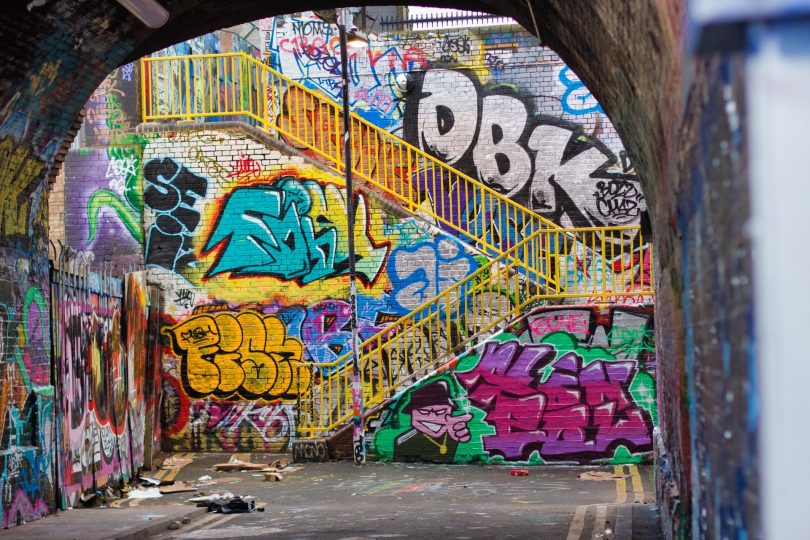Graffiti and street art are often used interchangeably to describe any kind of art painted or drawn on a public surface.
And although you’d be right to assume graffiti and street art are similar, both types of art have differences in their own right.
Mostly due to the different audiences they’re aimed at, the legality of each style and what the art depicts.
In this article, we take a look at the main differences between street art and graffiti.
Plus, we look at examples of both art forms to clearly illustrate the differences between graffiti vs street art.
Contents
What’s the difference between graffiti and street art?
The main difference between graffiti and street art is that graffiti is a name-based art aimed at an audience of graffiti artists. Unlike graffiti, street art is based on words, images and symbols aimed at a public audience.
Graffiti artists are focused on promoting their name (or tag), with the intention of gaining respect from other graffiti artists. This is fundamentally different to a street artist’s motivation, which is for their art to be appreciated by the wider public.

Legal differences between graffiti and street art
Another key difference between graffiti and street art is that street art is commonly done with permission. For example, a street artist might paint a mural on the side of a building with the building owner’s permission.
This is different to graffiti where artists instead tag their names in public spaces mostly without permission. Painting without permission defines graffiti culture, as graffiti artists gain more respect for painting in high-risk, illegal places. For example, painting on trains.

Examples of graffiti
To get a clearer understanding of the differences between graffiti and street art, let’s take a look at a few examples of both art forms, starting with graffiti.
Tags
Tags are the most common style of graffiti, and arguably the most iconic. It’s a graffiti artist’s stylised signature and is often the starting point for any graffiti artist.
Although tags are usually done in the streets, they’re not considered street art because they’re aimed at communicating with other graffiti artists. They’re also mostly done without the permission of the property owner they’re written on.
Common tools used for tags are marker pens, spray paint and graffiti stickers.

Throw ups
Throw ups are another classic style of graffiti characterised by rounded letters painted with two colours. Throw ups avoid intricate details as they’re designed to be thrown up (or painted) as fast as possible. Hence the rounded style.
Again, although you’ll find these on the street, they’re mainly for other graffiti enthusiasts to appreciate. Plus, throw-ups revolve around promoting a graffiti tag, unlike street art that’s more concerned with imagery.

Examples of street art
Now we’ve got a better idea of how to spot graffiti, here are a few examples of street art for comparison.
Murals
Murals are a type of street art that uses imagery and sometimes letters and symbols as a display of public artwork.
Murals can have loads of different purposes, such as being an advertisement, dedicated as a tribute to someone or something, or even as a form of activism.
This kind of public artwork has different motivations behind it compared to graffiti writing, as the artist’s name isn’t the central focus of a mural.
Big murals are almost always done with the permission of the building owner too, and sometimes the artists get paid for their work unlike with graffiti.
Murals are also much easier on the public eye compared to graffiti, as they’re designed to be appreciated by a wider audience.
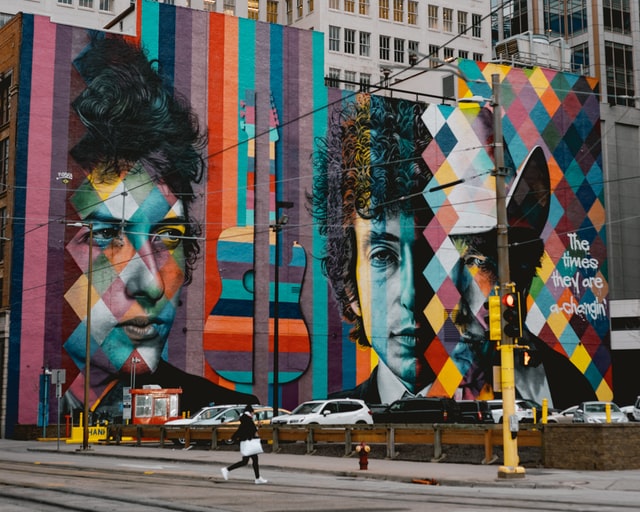
Wheatpaste
Wheatpasting is another common form of street art that uses posters to display images in public places.
It’s a common way of provoking the public to think as wheatpaste posters sometimes display controversial or abstract imagery. They’re also commonly used by activists to spread messages and increase public awareness of their cause.
Although wheatpasting is usually done without permission, as it’s aimed at a public audience and doesn’t promote a graffiti tag, it’s recognised as a form of street art.
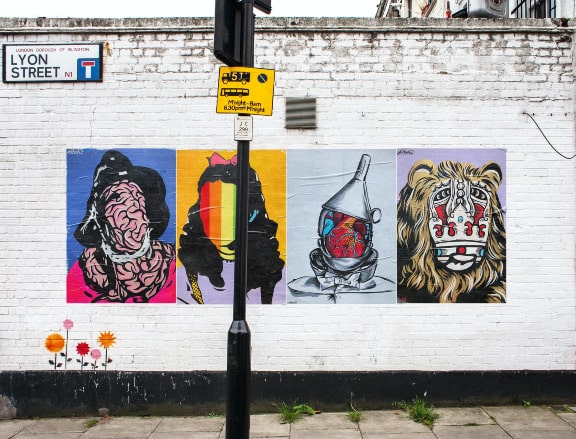
Examples of famous graffiti artists
To get a better idea of the difference between graffiti and street art, it’s useful to take a look at some of the famous graffiti artists in each category.
Although it’s certainly worth noting that many artists straddle the line between graffiti and street art, or take elements of each in their work. This is, of course, what makes understanding the difference difficult.
But by looking at the artists alongside some examples of their work, we should get a better idea.
Cornbread
Cornbread is famous for being considered the first modern graffiti artist after he began tagging his name ‘Cornbread’ around Philadelphia in the late 1960s.
He’s widely considered a graffiti legend as he set the fundamentals for graffiti we know today: tag your graffiti name illegally in as many places as you can to gain respect from other writers.
Cornbread is a clear-cut example of the difference between graffiti and street art as his early days of tagging were never done for the public to appreciate. It was for other graffiti writers to see instead.
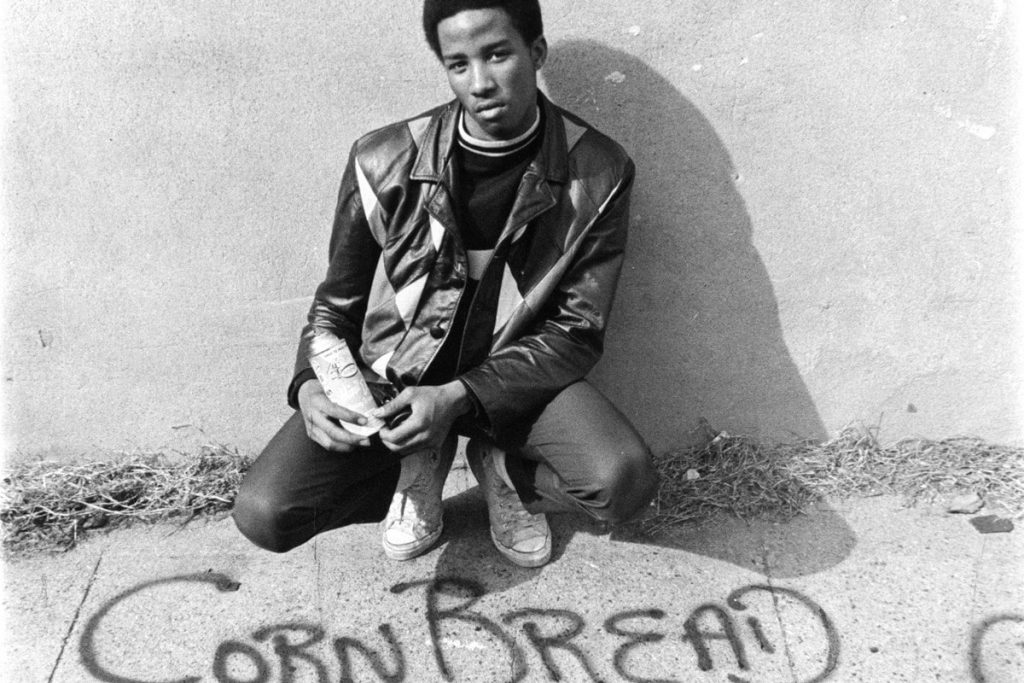
Seen
Seen is an American graffiti artist from New York famous for his art on New York City’s Subway system throughout the 1970s.
Having risen to fame across the globe with his feature in Subway Art (well known for being one of the best graffiti books ever made), his style inspired a generation of graffiti artists set on replicating New York’s vibrant graffiti scene in their own city.
Seeking permission for his work both on the streets and on subway trains was never an option for Seen. Although Seen and other graffiti artists would collaborate on mural-like productions across New York, the focus would always be on their graffiti names.

Examples of famous street artists
Now we’ve got an idea of famous graffiti artists and their motivations, let’s take a look at some famous street artists for comparison.
Banksy
Although Banksy is widely known as a graffiti artist (which may have been the case in their early career), Banksy’s work falls more into the category of street art. Here’s why:
Banksy no longer uses their art to promote their name, unlike graffiti artists do. They instead use imagery placed artistically in public spaces in order to provoke a response from the public.
Although much of Banksy’s work is done without permission, their focus on depicting images for the public to appreciate relates far more to street art.
Banksy’s use of stencils also sets them apart from graffiti artists. This is because graffiti is defined by freehand style by using tools like markers and spray paint.
Simply spraying the back of a stencil cut out isn’t considered skilful in graffiti culture as it requires no can control – so ‘true’ graffiti artists tend to avoid this style.
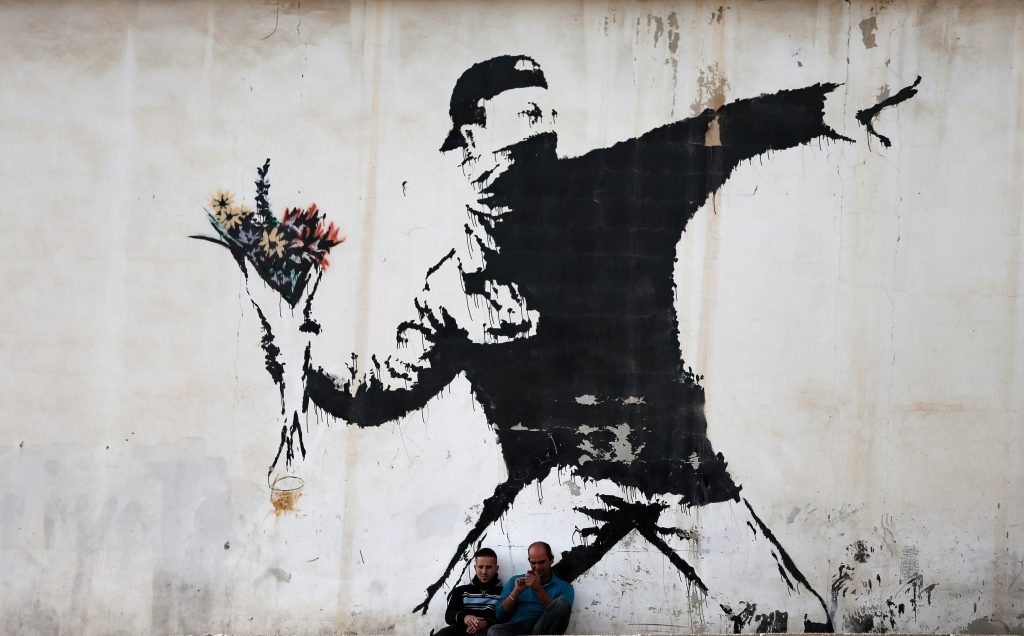
Miss.Tic
French-born street artist Miss.Tic has been active since 1985 and is famous for her stencil art throughout the streets of Paris.
She’s widely respected in both street art and graffiti communities for depicting female characters in her work alongside poetic quotes in her native language of French.
Miss.Tic blurs the line between graffiti and street art, however, as she signs most of her work with her signature – which could be considered a tag. She also paints mostly without permission, so it may be fair to call her work graffiti.
But in the true definition of graffiti, the focus is not on her name but on her quotes and imagery and the effect it can provoke on the public. Miss.Tic doesn’t seek recognition based solely on her name, but instead within her artwork.
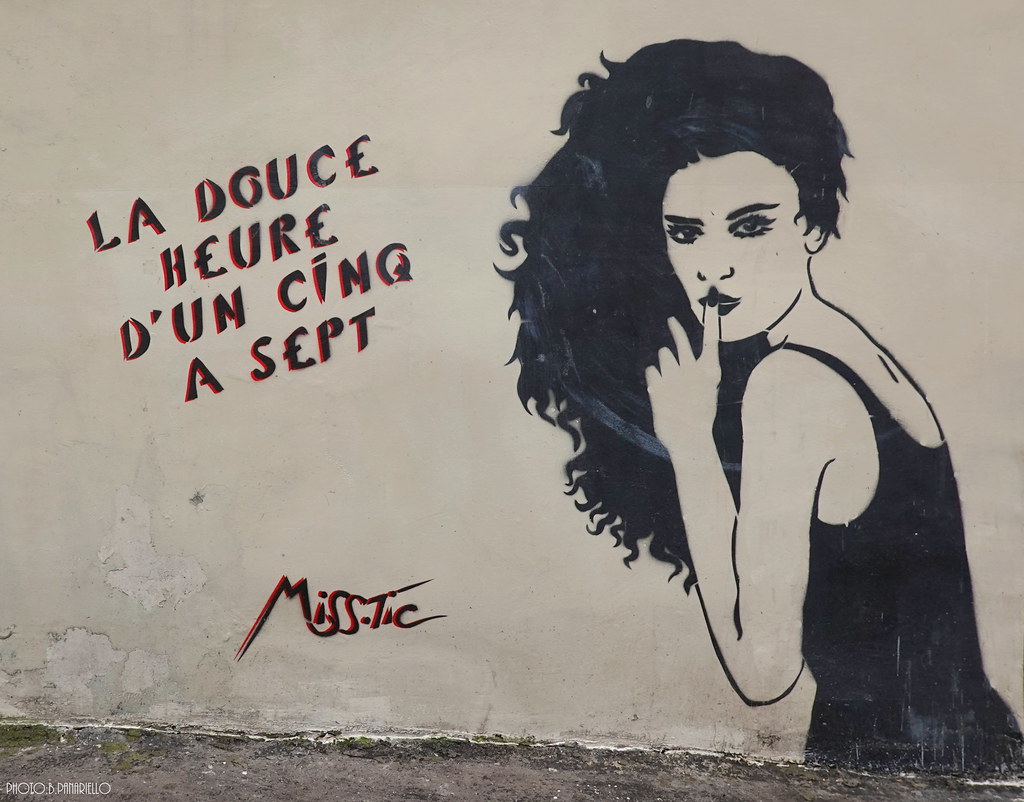
Summary of graffiti vs street art
With the definitions and examples considered, it’s clear that there are many differences between graffiti and street art. To summarise:
- Graffiti is name-based. The primary motivation for graffiti artists is to promote their graffiti via tags, throw-ups and pieces. This is done in order to gain respect and recognition from other graffiti artists and enthusiasts.
- Street art is image-based. For street artists, they focus on using images to provoke thoughts and feelings in their art. Their audience is much broader than graffiti artists, as their art is designed to appeal to the public.
- Graffiti is mostly painted without permission. Graffiti is largely an act of rebellion, so most name-based graffiti is painted illegally without permission. The illegality of this art form is a defining element of graffiti culture.
- Street art is mostly painted with permission. Although street artists might start their careers painting without permission, or continue to occasionally paint illegally, most street art is legal. It mainly comes down to whether the art is name-based or image-based to decide which category it falls into.
To finish – don’t worry if you get graffiti and street art mixed up.
They have a lot of things in common and graffiti or street artists won’t get upset if you get their art form wrong.
This article was written to help tackle the question in a bit more depth using images and examples. So hopefully you’ve learnt a bit more about the differences and are better at knowing your graffiti from your street art.
Did I miss anything? Or maybe you don’t agree with my graffiti vs street art examples. Drop a comment and let me know.
